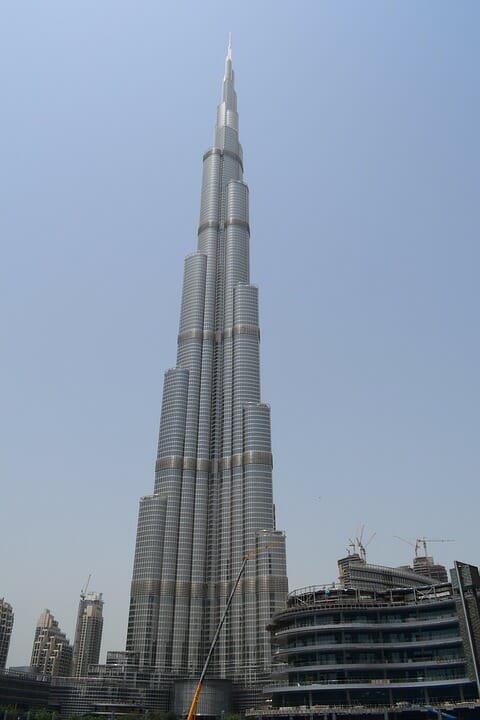
As technology continues to progress, the world is witnessing more and more unusual building and structures being created. With these increasingly unique buildings comes and increasingly unique set of demands for its internal systems, including the vital aspect of climate control.
In this article, we will explore the various different approaches to climate control for advanced buildings from around the globe.
Cooling the tallest building in the world
Towering at 2,716.5 feet tall under an average desert temperature of 41°C, the Burj Khalifa truly is a triumph of technology. Keeping a tower this tall cool is a task in and of itself, let alone with the surrounding temperature being so extreme. So, how do they do it?
The secret to keeping the Burj Khalifa cool boils down to a number of variables. Primarily, ice-chilled water is used to cool the building, and this is supplied by three plants. During off-peak hours, the central water plant creates an ice slurry that makes the water colder than a chiller could manage. This chilly water is sent through the tower in a series of pipes to heat exchangers at three different levels. Once the cold water has cooled the air for the air conditioning unit to use, it is sent back down to the central water plant again.
There are a few key benefits to this approach:
- It is better for the environment, as it allows the tower to make savings on energy use
- It reduces the amount of space needed to dedicate to cooling equipment
Initially, the air conditioning system had to be activated steadily over a period of one week. This was to prevent pockets of warm air from forming in the building.
There are some safety nets in place too. As a back-up, the tower also has four air-cooled chillers to support the data centres if needed.
A cool 360° view
Brighton is home to the 450-foot British Airways i360. As the world’s tallest moving observation tower, this building set a new challenge for climate control — the structure houses a restaurant, a shop, conference rooms, exhibition spaces, wedding venues, and of course, a 360° panoramic view in its moving 94-ton pod.
The building’s heating is powered by renewable energy, thanks to the Daikin VRV IV systems installed within it. A constant supply of fresh air is circulated by heat recovery ventilation units throughout the building — this is crucial for reducing the demand on each air conditioning unit that needs to balance the indoor temperature with a significantly different outside temperature.
The building has a few location-based requirements to work around too. One, the units need to be out of sight. Two, they need to be able to withstand the corrosive nature of salty sea air! Therefore, the VRV IV outdoor units have been installed out of sight, and are treated with a specialist factory-applied Blygold coating, to protect them from the salt in the air. The result is an energy-efficient, streamlined, and sea-air-ready HVAC system that supports this complex and unique building.
Reusing energy
Amazon’s Seattle offices have an innovative approach to heating. The building is heated by capturing the warm air produced by data centres — a great way to re-use waste for a key purpose!
The data centres in question aren’t actually Amazon’s own. The heat is collected from the Westin building across the street from their offices. It’s a two-fold victory, as it helps Amazon to save energy and gives Westin a good way of sustainably dealing with waste heat. The heated water is piped from the data centres to a central plant belonging to Amazon, and is put through heat-reclaiming chillers. This is then used to supply the office’s heating needs, and the now-cold water is sent back to Westin to help cool their data centres. Amazon is set to save 65 million pounds of coal’s worth of CO2 emissions over 25 years with this approach.
The future of climate control
Undoubtedly, with buildings only getting bigger and more complicated, so too must our climate control methods adapt to suit. The Independent reported on another ambitious project blossoming in Dubai — the world’s largest shopping centre. But calling it a shopping centre seems a little unfair; the project intends to cover 48 million square feet, making it a shopping city.
With the world’s largest theme park, a Broadway-style theatre district, and an Oxford Street inspired shopping area, the Mall of the World is a gargantuan undertaking on so many levels. Crucially, it is being touted as the first climate-controlled city in the world.
How much further will we see climate control methods blend natural resources with new technology? The world’s structures are only going to get more complex, so it will be interesting to see how requirements like heating and cooling are addressed in such builds.
